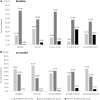Quality of life, disease activity and preferences for administration routes in rheumatoid arthritis: a multicentre, prospective, observational study
- PMID: 36133962
- PMCID: PMC9486987
- DOI: 10.1093/rap/rkac071
Quality of life, disease activity and preferences for administration routes in rheumatoid arthritis: a multicentre, prospective, observational study
Abstract
Objective: We aimed to evaluate quality of life (QoL), disease activity, compliance to treatment, patient and physician preferences for route of administration (RoA), status of health and pain in RA patients starting advanced treatments or needing a switch, and the factors associated with patient preferences.
Methods: A multicentre, prospective, observational and 1-year follow-up study was conducted, between 2015 and 2020, in adult RA patients using advanced treatments for the first time or needing a switch in their current treatments. All the data collected were entered into electronic case report forms. DAS in 28 joints with ESR [DAS28-4(ESR)], EuroQol 5-Dimensional Questionnaire (EQ-5D), HAQ Disability Index (HAQ-DI), Compliance Questionnaire for Rheumatology (CQR-19), Work Productivity and Activity Impairment Instrument (WPAI) and Patient Global Assessment-Visual Analogue Scale (PGA-VAS) questionnaires were used for longitudinal assessments.
Results: Four hundred and fifty-nine patients were enrolled. Three hundred and eight patients (67.1%) attended the final study visit at 12 months and were included for comparative analyses. Irrespective of RoA, the disease activity and QoL improved significantly at 12 months, whereas compliance worsened. At baseline and 12 months, EQ-5D and DAS28-4(ESR) scores were significantly correlated (P < 0.001). The WPAI scores changed significantly in favour of better outcomes over 12 months after initiation of advanced treatment or switching (P < 0.001). A higher proportion of patients preferred an oral RoA, in comparison to physicians (53.6% vs 31.4%; P < 0.001). Patient and physician RoA preferences were independent of gender, age, disease duration, advanced treatment type and the EQ-5D-3L, DAS28-4(ESR), HAQ-DI, PGA-VAS and CQR-19 scores at baseline.
Conclusion: The oral route was more frequently preferred by patients compared with physicians, although patients' preference rates showed a slight increase towards the end of the treatment, which might be an important factor for RA outcomes. Better control of disease activity and QoL were achieved at 12 months, regardless of RoA.
Keywords: DAS; ESR; RA; advanced treatment; patient preference; quality of life; switch.
© The Author(s) 2022. Published by Oxford University Press on behalf of the British Society for Rheumatology.
Figures


References
-
- Alamanos Y, Drosos AA.. Epidemiology of adult rheumatoid arthritis. Autoimmun Rev 2005;4:130–6. - PubMed
-
- Lee DM, Weinblatt ME.. Rheumatoid arthritis. Lancet 2001;358:903–11. - PubMed
-
- Cross M, Smith E, Hoy D. et al. The global burden of rheumatoid arthritis: estimates from the global burden of disease 2010 study. Ann Rheum Dis 2014;73:1316–22. - PubMed
-
- Akkoc N, Akar S.. Epidemiology of rheumatoid arthritis in Turkey. Clin Rheumatol 2006;25:560–1. - PubMed
-
- Smolen JS, Landewé RBM, Bijlsma JWJ. et al. EULAR recommendations for the management of rheumatoid arthritis with synthetic and biological disease-modifying antirheumatic drugs: 2019 update. Ann Rheum Dis 2020;79:685–99. - PubMed
LinkOut - more resources
Full Text Sources
Miscellaneous
